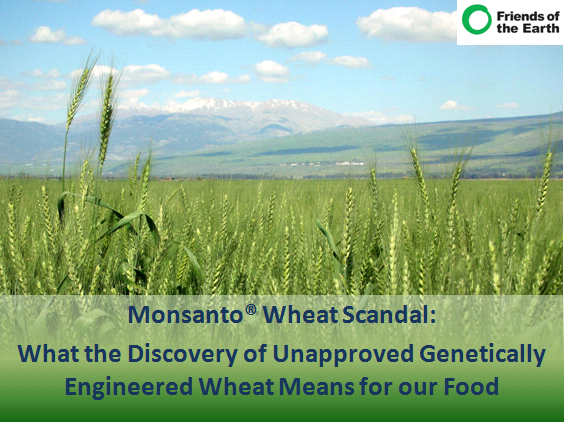- Blog
- Sustainable Economic Systems
- Monsanto wheat scandal: What the discovery of unapproved genetically engineered wheat means for our food
Monsanto wheat scandal: What the discovery of unapproved genetically engineered wheat means for our food

Donate Now!
Your contribution will benefit Friends of the Earth.
Stay Informed
Thanks for your interest in Friends of the Earth. You can find information about us and get in touch the following ways:
It has just come to light that genetically modified wheat has been found growing on a farmer’s land in eastern Oregon. The problem? No genetically engineered wheat has ever been approved for US Farming.
In 2004 Monsanto, the world’s biggest genetically engineered seed company, pulled their GE wheat from the USDA’s approval process because of growing pressure from some of the most important international importers of United States wheat, including Japan, the UK, Malaysia, and Canada. These international consumers were weary of having genetically engineered foods as part of their food supply, and because Monsanto realized they would have no market for their wheat (since the US exports over 50% of its wheat), it abandoned the project. This is of course after they had already implemented field tests of the wheat in 16 states. The last field test of this GE wheat in Oregon was supposed to have been in 2001, and yet here it is. What implications does this have for the US wheat market, and for US wheat farmers?
Japan has already canceled an order of US wheat, fearing contamination, until the issue has been resolved in the US. Likewise, the EU will be testing incoming wheat shipments for GE exposure, blocking any shipments that show corruption by genetically engineered strains, and South Korea, China, and Malaysia are monitoring the situation closely. Asian importers consume about 1/3 of the world’s wheat, and the US is their number one supplier. If our wheat is banned, US wheat farmers and the industry could stand to loose millions of dollars.
The worst part is that this is not the first time something like this has happened. Starlink Corn was a strain of genetically engineered corn created be a company called Aventis to express the natural pesticide Cry9C, and was approved only for feed for livestock due to the concern of Cry9C being a human allergen. Yet, in 2000 the Starlink Corn was found to have contaminated corn intended for human consumption and thanks to the efforts of nonprofits such as Friends of the Earth, as well as international pressure, the product was recalled. As much as $288 million was lost due to the recall of contaminated corn products both in the US and abroad. Again in 2006, Bayer’s Liberty Link rice, also not approved for commercial use, was discovered to have contaminated the US rice supply and cost us as much as $1.29 billion in lost rice exports and food recalls.
Clearly, these biotechnology companies that create genetically engineered crops do not have as much control over the distribution of their crops as they would like us to believe they do. For an example, look no further than the Mexican corn scandal. Mexico is one of the last hold-outs of non-GE corn in the world, and boasts hundreds of genetic varieties of corn including those most closely related to the earliest strains of corn known to man. They were fiercely against genetically engineered corn from the beginning, and never planted any anywhere in their country’s soil, yet GE corn was found to be contaminating their fields nonetheless. Now they must patrol their fields ruthlessly if they want to keep that contamination at bay, but the damage is done.
This latest GE wheat scandal is just another reminder that genetically engineered organisms pose a threat to conventional and organic crop varieties around the world. They say that the wheat is not harmful for human consumption, but that’s not the point. The point is that it is incredibly naïve to treat living, reproducing plants (and maybe soon animals) like discrete products that we can control completely. They are living organisms that want to reproduce and evolve and they can, and have, and will spread and contaminate non-GE varieties everywhere. Maybe it’s not dangerous today, but what about tomorrow? What about next time? And if the USDA didn’t know this genetically engineered wheat was in our fields, how can we trust them to know which varieties of other GE crops are planted where, and which are harmful to the environment or human health?
If we can’t control genetically engineered organisms now, what makes us think that creating more GE crops in a business as usual manner isn’t going to end up exactly the same: with contamination, novel food safety risks, and rampant economic losses for farmers who are already struggling to stay afloat?
Image Credit: Wikimedia Commons
